Dispatch of Medical Professionals
Home > Dispatch of Medical Professionals > Dispatch List > HICARE mission to U.S.A.
HICARE mission to U.S.A.
The purposes of the mission are:
To discuss more effective ways of inviting American medical personnel to Hiroshima for training.
To promote the establishment of network between HICARE and its former trainees / organizations supporting hibakusha in U.S.A.
Period:
Members:
Jitsuro Yanagida Executive Director, Hiroshima Prefectural Medical Association, HICARE Chief Executive Secretary
Two HICARE Secretariats
Organizations/Medical Personnel (in order of visit):
American Society of Hiroshima-Nagasaki A-Bomb Survivors (A.S.A) (Los Angeles)
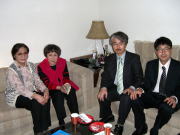
Ms. Kaz Suyeishi, President of the Society,and its member
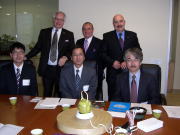
Dr. Ralph J. D. Libero, President of the Association (the right in the back row),Dr. Robert A. Bitonte, Treasurer of the Association (the middle in the back row),Mr. Arthur E. Auer, Chief Executive Officer of the Association (the left in the back row)
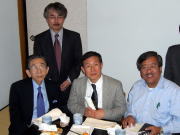
Dr. Fred Y. Sakurai, Chairman of JCHI (the left in the front row),Dr. Takeshi Matsumoto, Managing Director of JCHI (the middle in the frontrow),Dr. George J. Yamauchi, Treasurer of JCHI, and 1994 HICARE Trainee (the right in the front row)
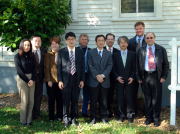
Dr. Stephen E. Follansbee, President of the Society,Ms. Mary Lou Licwinko, Executive Director of the Society,and its members
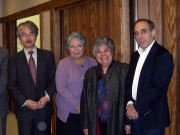
Mr. Robert L. Rusky, President of the association,Ms. Geri Handa, Secretary-General of the association Ms. Seiko Fujimoto, Executive Director of Japanese Benevolent Society of California
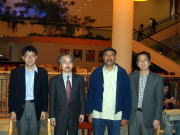
Dr. Amir Huda, 2006 HICARE Trainee (the second from the right)
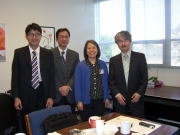
Dr. Kay Yatabe, 1996 HICARE trainee (the second from the right)
Physicians working in cooperation with the Hiroshima Prefectural Medical Association
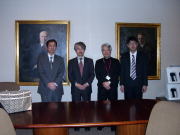
Dr. Kenji Irie (the middle)
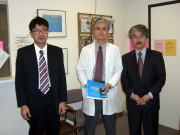
Dr. John Umekubo (the second from the right)
Impressions by Dr. Yanagida:
HICARE has been accepting overseas medical personnel since its establishment in support of victims of the Chernobyl accident, nuclear testing in the Semipalatinsk region in Kazakhstan, as well as in support of hibakusha living in North America, South America, and the Korean Peninsula. HICARE invites trainees mainly from Brazil in South America for one-to-three months of training every year. Within 5 years of its established, HICARE had invited a total 11 doctors from Los Angeles, San Francisco, and Hawaii, although since that time has accept no other North American trainees. It is rather difficult for busy doctors to get one-month off work.
As such, HICARE created a new one-week program concentrating on the facts of the A-bombing, the acute and chronic effects of radiation on the human body, and on health care for hibakusha. For participation in this program HICARE invites a group of six doctors and/or nurses every year.
Furthermore, a new system for subsidizing medical expenses for overseas hibakusha was launched in 2005. The procedure and application process for the “Hibakusha Health Care Allowance?Eis available in the patient’s country of residence. It is thus essential that doctors acquire the necessary knowledge for describing in detail the hibakusha condition on the application form.
On the basis of this situation, HICARE dispatched a mission consisting of the HICARE Chief Executive Secretaries and two secretariats to Los Angeles and San Francisco where many hibakusha live.
In spite of the short eight-day stay (two and half a days in each city), we had the privilege of meeting many people concerned with hibakusha treatment including the President, Executive Director, and Secretary-General of both the Los Angeles County Medical Association and San Francisco Medical Association. Both have been cooperating with the Hiroshima Prefectural Medical Association with regards to the examination of North American hibakusha. In addition, we met with physicians working in cooperation with our association, the doctors supporting the hibakusha, former HICARE trainees, and the President and Secretary-General of the Friendship of Hibakusha association.
We believe that the HICARE training program explanation was well received. Above all, the one-week program seemed to be quite welcome, some doctors expressing the possibility that several of them participate in the program, taking one-week holidays.
Two former HICARE trainees gave us their frank opinions regarding the significance of the program, as well as several areas that could be improved. I believe they will contribute to the future improvement of the program.
Unexpectedly, I was repeatedly asked for information about the development of a radiation-emergency system by a number of doctors. In Japan, a radiation emergency medicine network in the event of a radiation accident has already been established; Hiroshima University is the key organization in charge of western Japan. A similar network has recently been established in South Korea. The U.S. Government is also eager to prepare for the establishment of a similar system. Many doctors seem to be interested in such a system as well.
HICARE is considering the creation of a training program to address the issues that arise regarding radiation-emergency systems and their implementation.
In conclusion, the visit to two cities in U.S.A. provided us fruitful results beyond our expectations. I would like to express my sincerest thanks to all people we met in U.S.A.



